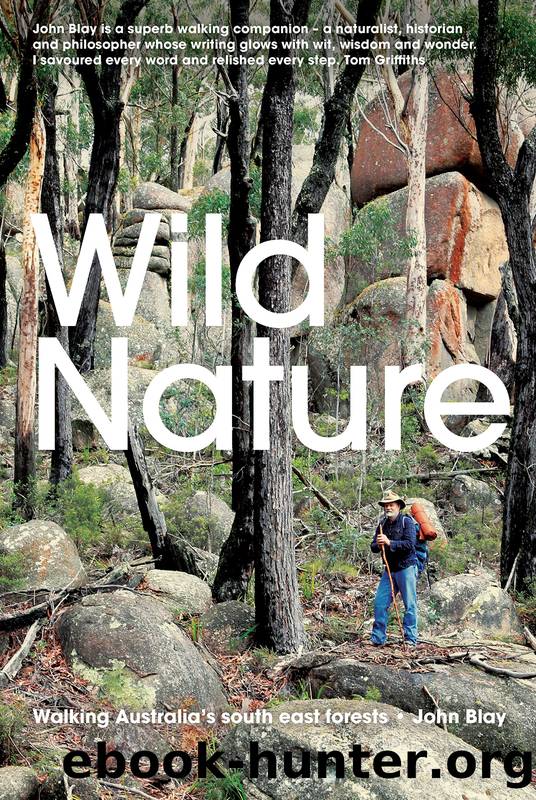Wild Nature by John Blay

Author:John Blay [Blay, John]
Language: eng
Format: epub
Publisher: NewSouth Publishing
Published: 2020-07-09T16:00:00+00:00
The peak
It’s been cold and raining and there was hail. Snow has been forecast down to 1000 metres, which means the top hundred metres of Pheasants Peak could well be splattered white. The prospect of witnessing it (especially in mid-November) is too great and draws us out before the ice of dawn. The way up in such open forest is as easy cross-country as it is following the ruts of the old fire trail. At about 900 metres the boulders start. Soon there are great boulders 10 and 20 metres round all piled on top of one another so that by clambering to the top you can see out over the canopy of the silvertop ash westerly towards the mists of the Monaro and the Snowies. There is the hint of frost but no sign of the snow I had hoped for. My breath is coming out like a smoky campfire. It’s not so cold that Jacqueline has turned as blue and red as a waratah even though she says she has. A cup of tea before our departure would have helped. We come into the bands of much-scribbled white ash as we approach Yarramgun’s crest. The scale of it all takes your breath away. Boulders near the top are many times bigger than those further down the hill. Everything is rounded, the ups and the downs. Sometimes the great boulders have fallen over each other to make rock shelters and in other places they fit together like the pieces in a puzzle. It is a place of shadows and strange moods. It plays tricks on you.
Trees, silvertop and white ash, grow out of crevices everywhere. Then, amazingly, the fruit of the Wadbilliga ash, Eucalyptus paliformis, previously only known from the crest of Wadbilliga some 80 kilometres to the north. All these years it’s probably been mistaken for the white ash (Eucalyptus fraxinoides), as they look so similar and generally grow on the most difficult sites. But, forest time being so much slower and drawn out than human time, it points to one of the most special attributes of these forests, for they are a seething, hybridising, melting pot of eucalyptus evolution. Their ever-evolving adaptations to climate and geography is a world asset. One ongoing problem across the region is the difficulty in identifying eucalypts, because so many are not exactly one species or the other, being partly this, part that and even something else. One species mimics another, so that perhaps if one is attacked, at a certain point the other will distract the attackers. They communicate in ways not discernible to us. The forests yet have the capacity to surprise even the most hardened observers.
Touches of grass and shrubs scramble here and there. Somehow, among such tors, I’m put in mind of the human body, its roundnesses, folds and wrinkles, all made on the grandest scale and so it seems indecent to climb all over it and penetrate its recesses and mysteries. The compulsion to go further than before and explore remains at the same time as the mountaintop demands respect.
Download
This site does not store any files on its server. We only index and link to content provided by other sites. Please contact the content providers to delete copyright contents if any and email us, we'll remove relevant links or contents immediately.
Thinking Better by Marcus du Sautoy(613)
Invention by James Dyson(564)
Wanting by Luke Burgis(553)
The Ten Equations That Rule the World by David Sumpter(533)
Concepts of Space by Jammer Max;(526)
Merchants of Doubt by Erik M. Conway(520)
How We Got to Now by Steven Johnson(511)
The Smallest Lights in the Universe by Sara Seager(453)
God and the Multiverse by Victor J. Stenger(451)
Factfulness by unknow(449)
Ancient Knowledge Networks by Eleanor Robson;(413)
Floods, Famines, and Emperors: El Nino and the Fate of Civilizations by Brian Fagan(404)
On Creativity by Bohm David(400)
The Oxford Handbook of Philosophy of Mathematics and Logic by Stewart Shapiro(391)
The Science of Being Lucky: How to Engineer Good Fortune, Consistently Catch Lucky Breaks, and Live a Charmed Life by Peter Hollins(390)
The Scientist and the Psychic by Christian Smith(388)
The Surrender Experiment by Michael A. Singer(376)
Flood by Design (Design Series) by Mike Oard(371)
Science by John Gribbin(364)
